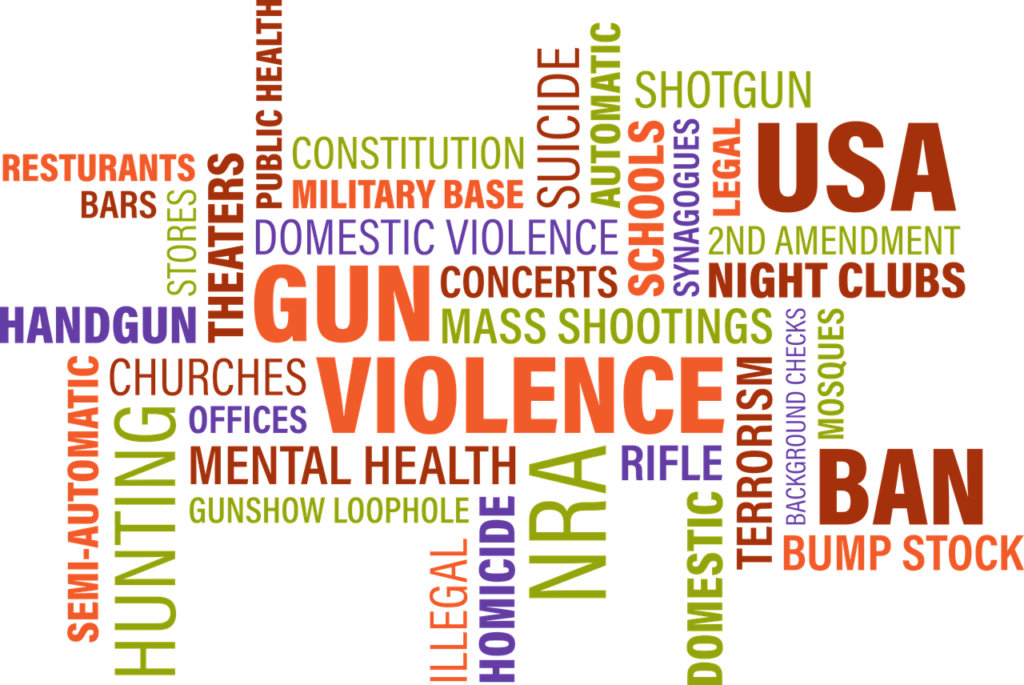
The nightmare has become all too familiar. A gun-wielding person enters a school, a church, a market, a night club or some other place and opens fire, killing or maiming many innocent victims before being killed, committing suicide, or getting arrested. In the aftermath, there is swift public outrage condemning the violence and demanding action. Public officials universally express sorrow and sympathy, while at the same time resorting to hackneyed partisan postures. Democrats blame Republicans for blocking responsible firearm restrictions and demand action. Republicans blame Democrats for wanting to take away guns from law-abiding Americans and say the solution is to focus on the person rather than the gun. Inevitably, the parties end up gridlocked over whether the primary cause of the problem is violent individuals, or weapons that are too easily accessible. No action is taken; and, tragically, it is only a matter of time before another mass shooting is in the headlines.
An Overview of This Series on Gun Violence
In this four-part series we’ll take a deep dive into gun violence in America. We’ll set aside the hyper-partisan rubric and apply a new methodology—one based on research and analysis—for making policy on the subject. In this first article we’ll examine how the blame game rubric has mostly failed to produce solutions to stem the growing tide of mass shootings, deaths, suicides, and injuries due to gun violence. We’ll also examine how this rubric has divided and angered Americans when it comes to gun control and gun violence. In the second article, we’ll apply research and analysis to better understand all the causes that contribute to gun violence and mass shootings. We’ll explore how gun violence is multi-faceted, both in terms of the problems and the solutions. In the third article we’ll put the spotlight on mass shootings and assault rifles. And, in the final article, we’ll look at historical trends, including the views of Americans on the many aspects of gun violence and gun control. We’ll identify and explore common interests and common ground solutions that could actually reduce the incidence of gun violence and gun death in America.
Age-Old Partisan Narratives
Whether gun violence or a mass shooting occurred thirty years ago or only in recent days, the narratives used by Republicans and Democrats haven’t changed much. Let’s recount a few quotes coming from members of Congress regarding the most recent mass shooting at a private elementary school in Nashville, Tennessee:
Republican Narratives
Senator John Thune (R-South Dakota):
“Our thoughts are with the families, the victims with the community. We are grateful for the quick rapid response of law enforcement, and I think with respect to any discussion of legislation, it’s premature. There’s an ongoing investigation. And I think we need to let the facts come out.”
Representative Tim Burchett (R-Tennessee):
“Three precious little kids lost their lives, and I believe three adults on the way. And the shooter, of course, lost their life, too. So it’s a horrible, horrible situation. And we’re not going to fix it. . . . if somebody wants to take you out and doesn’t mind losing their life, there’s not a whole heck of a lot you can do about it… I don’t see any real role that we can do other than mess things up, honestly, because of the situation.”
House Majority Leader, Steve Scalise (R-Louisiana):
“We’ve talked about things that we can do. And it just seems like on the other side, all they want to do is take guns away from law-abiding citizens before they even know the facts. The first thing they talk about is taking guns away from law-abiding citizens… We’ve talked about the need to improve mental health in this country, and that’s been a driver of a lot of these shootings as well.”
Representative Chris Stewart (R-Utah):
“There’s a lot of things we could do with protecting our children. Let’s focus on protecting schools, not on banning, again, 84 percent of the weapons in the country… We protected airports. We protect people who are flying in airplanes. Why can’t we implement a lot of those same procedures to protect children?”
These quotes typify the Republican response, which more broadly includes the following narratives:
- Democrats want to take away your guns and deny your 2nd Amendment rights.
- Taking preemptive action after a mass shooting without gathering the facts is irresponsible and playing politics.
- Gun control laws don’t work—they simply punish responsible gun owners, and most are unconstitutional. Criminals, who mostly acquire their guns through illegal channels, don’t obey gun laws. Background checks are ineffective.
- The real problems surrounding gun violence involve crime, mental health, and lack of security.
- The best way to reduce gun violence is to arm the public: “The only way to stop a bad guy with a gun is with a good guy with a gun.”
- The Democrats’ radical anti-police agenda has caused a dramatic rise in crime across America, leading to more people purchasing firearms as a means of defending themselves and their families.
Within the context of the hyper-partisan blame game rubric, the Republican narratives are designed to do more than simply block gun control legislation. Elected Republican politicians and candidates use these narratives to fire up their bases, win elections, and blame Democrats for the lack of action. The narratives stoke fear and anger toward Democrats and their candidates, leaving elected Republicans as the protagonists who protect constitutional rights and prevent government overreach. Conservative media outlets also use these narratives to increase their audiences and generate more revenue.
Democratic Narratives
Representative Mike Thompson (D-California):
“There have been 130 mass shootings this year. After most, we hear silence from extremist Republicans, but after the Nashville school shooting, we got a mix of thoughts, prayers and deflection… Instead of getting serious about taking on the gun violence epidemic that kills over 130 Americans every day, they are trying to deflect and distract from their lack of action on this issue. How many more kids need to get murdered before House Republican Leadership steps up and puts gun violence prevention legislation on the House calendar?”
Senator Chris Murphy (D-Connecticut):
“It is beyond me why Republicans who claim to care about the health of our kids don’t seem to give a crap about our children who are being exposed to these epidemic, cataclysmic rates of gun violence.”
Senator Dick Durbin (D-Illinois), Majority Whip
“But as today’s shooting in Nashville, Tennessee demonstrates, there is more work to be done. The fact that this is a daily occurrence in America is unconscionable. We are going to learn more details in the hours and days ahead about what actually happened in Nashville, but we already know what must be done to keep our children and communities safe from deadly shootings. I strongly—strongly—support bills that ban assault weapons from civilian use and close gaps in our background check system. I cannot imagine the Founding Fathers would even envision what we are allowing today in the name of words that they wrote in the Second Amendment to the Bill of Rights.”
These quotes typify the Democratic response, which more broadly includes the following narratives:
- No American should be afraid to go to school, their house of worship, a shopping mall, a nightclub, a concert, a movie theater, or a college campus because they fear getting shot.
- Too many Republicans act as if gun violence is just a fact of everyday life. They offer thoughts and prayers when tragedies unfold; yet they block even the smallest reforms, while accepting millions from the National Rifle Association.
- America is not powerless to prevent gun violence. We should strengthen background checks for those who want to purchase a firearm. Guns shouldn’t fall into the hand of terrorists (domestic or foreign), domestic abusers, violent criminals, or those who have shown signs of danger towards themselves or others. We can make such changes while respecting the rights of responsible gun owners.
- Highly lethal weapons of war don’t belong in the hands of civilians. Assault rifles should be banned, as well as high-capacity magazines.
Within the context of the blame game rubric, the Democratic narratives are designed to do more than spur the passage of gun control legislation. Elected Democrat politicians and candidates use these narratives to fire up their bases, win elections, and blame Republicans for lack of action. The narratives stoke frustration and anger toward Republican candidates who continue to block gun control legislation despite tragic deaths and repeated mass shootings. Liberal media outlets also use these narratives to increase their audiences and generate more revenue.
No National Solutions While States Have Chosen Sides
ABC News recently produced a story that covers the history of gun violence in the US, including gun legislation that Congress passed and rejected over the past 30 years. Mass shootings at places like Columbine, Sandy Hook Elementary, Marjory Stoneman Douglass, the Pulse Nightclub, and the Las Vegas Strip all prompted the introduction of federal legislation. The vast majority of attempts ended in failure, including multiple attempts to pass universal background checks, bans on assault rifles, limits on high-capacity magazines, and lengthening waiting periods.
One of the only successful legislative efforts was the Federal Assault Weapons Ban (Public Safety and Recreational Firearms Use Protection Act) passed in 1994. The ban, which included a ban on high-capacity magazines, only applied to future sales. Thus, current owners of such rifles and magazines were allowed to keep and transfer these items. It also included many exemptions as to outlawed weapons, and, more importantly, had a sunset date of 10 years. In September 2004, the assault weapons ban ended in accordance with its sunset date, despite attempts to extend it.
What has effectively been a 30-year stalemate on gun legislation ended with the enactment of the Bipartisan Safer Communities Act in June of 2022. This $13.2 billion compromise was supported by Democrats as well as 15 Senate Republicans and 14 House Republicans. Along with a few modest gun controls, the legislation mostly provides resources and incentives to address mental health matters, including the following:
- Expanded background checks for individuals under the age of 21 who purchase firearms.
- $11 billion for mental health services.
- Individuals convicted of a domestic violence misdemeanor or felony in dating relationships are prevented from purchasing firearms for five years.
- $750 million for state grants to implement crisis intervention order programs, also referred to as red-flag laws, that would allow authorities to confiscate firearms from individuals who have been determined by a court to be a significant danger to themselves or others.
- $2 billion for community-based violence prevention initiatives.
While the legislation is significant because of its major focus on the mental health aspects of gun violence, Democrats were unable to get any Republican votes for such solutions as universal background checks, longer waiting periods, limits on high-capacity magazines, or a ban on assault rifles.
The blame game rubric has played out in a very different way when it comes to gun control legislation enacted by the states. If you go to the Giffords website you can find gun laws by state and also a “gun law scorecard” that rates each state’s gun laws (annually updated). Not surprisingly, you’ll find that states usually under Republican control have lax gun laws, and states under Democratic control have tougher gun laws. What you’ll also find are trends: over recent years the Republican states have loosened more and more restrictions (such as open or concealed carry laws and defend your ground policies); while Democratic states have tightened more and more restrictions (such as bans on assault weapon and high-capacity magazines, or more far-reaching red flag laws).
Congress Remains Gridlocked, Toll of Gun Violence Climbs
Sadly, gun violence, mass shootings, deaths, and injuries have continued to go up and up in recent decades. Since the late 1990’s, gun-related deaths (homicide and suicide) have gone from about 27,000 per year to over 48,000 per year. And, as the problem worsened, more focus has been placed on ensuring accurate and complete statistics. Started in 2013, The Gun Violence Archive is an excellent online source for statistics and research on gun violence incidents over (going back to 2014). For instance, there are detailed statistics on mass shootings by year, as well as summary reports for each year since 2014.
Below is a summary chart depicting a 7-year review (2016-2022):

Over this time period we see clear trends as to increased deaths, increased suicide by gun, increased injuries, and increased mass shootings.
The toll of gun violence, however, goes far beyond the tragic deaths, suicides, and injuries. Schools alone are spending billions per year in hardening their campuses. Businesses are also incurring costs for such items as camera systems, plexiglass, motion sensor lights, bars on doors, bulletproof windows, security staff and other security strategies. Other costs are incurred when businesses are forced to curtail business hours because customers are afraid to shop at night.
Finally, the psychological toll of gun violence is also extensive—especially in terms of mental health and well being. Children and older students are afraid to go to school or college for fear they might get shot. Hardened facilities and active shooter drills remind them daily of the danger. Parents also suffer anxiety regarding the safety of their children. And, more broadly, the well being of a broad swath of Americans is affected because they are afraid to go to the market, a movie theater, a church, a nightclub, a concert, or other places where mass shootings might occur.
Americans Remain Divided on Key Aspects of Gun Control
While the carnage of gun violence continues to climb, and every year seems to set a new record for mass shootings, Americans remain divided on key aspects of gun control. Here is a sampling from a recent FiveThirtyEight poll:
- 37% of Republican and 83% of Democratic respondents said they “strongly” or “somewhat” favor banning assault weapons.
- 24% of Democratic and 66% of Republican respondents said they “strongly” or “somewhat” favor arming K-12 teachers.
- 34% of Republicans and 87% of Democratic respondents said they were “very” or “somewhat” confident that stricter gun laws would reduce mass shootings.
- 9% of Democratic and 39% of Republican respondents said that the right of people to own guns is more important than protecting people from gun violence.
In a Pew Research Center poll (April 20, 2021):
- 81% of Dem/lean Dem and 20% of Rep/lean Rep said that gun laws should be more strict.
- 73% of Dem/lean Dem and 20% of Rep/lean Rep said that there would be fewer mass shootings if it was harder for people to legally obtain guns.
Conclusion: The Partisan Blame Game Rubric Has Failed America and Its People
Most unfortunately, the highly partisan narratives regarding gun violence and gun control have been counterproductive to legislative action to address the real and growing problem of gun violence and mass shootings in America. Democrats and Republicans have blamed and vilified one another while remaining mostly gridlocked on policy solutions. All the while, the American people remain divided and angry over partisan differences on gun control. This is a no-win for our country and unconscionable that we have done so little to prevent the deaths and maiming of tens of thousands of Americans each year.
Next in the Series
EXPLORE THE WHOLE SERIES
Gun Violence in America

As Gun Violence and Mass Shootings Surge, Partisan Politics Has Failed Us on Solutions (Part 1 of 4)

Gun Violence: What Can Research Teach Us? (Part 2 of 4)

Why Have Mass Shootings Surged and How Do We Stop the Carnage? (Part 3 of 4)

Leave a Reply